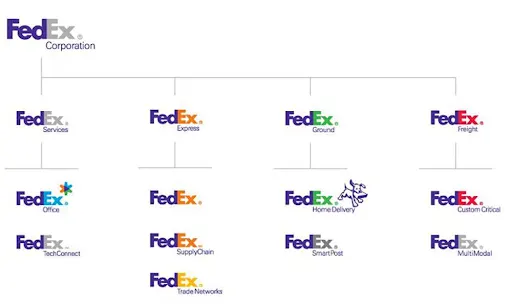Recently updated on May 21st, 2024 at 02:33 pm
What is a brand hierarchy?
Brand hierarchy refers to the brand strategy that focuses on the connections between business parts and processes. Business owners incorporate this strategy to help their market identify their products and services. To do so, companies categorise their sub-products based on their distinctive elements.
Others refer to this strategy as either brand architecture or brand structure. It applies to all businesses, and it’s vital to success. After all, a brand hierarchy has many benefits, but most business owners tend to overlook them.
Types of Brand Hierarchies
You know you have a good marketing strategy when you know the appropriate brand hierarchy for your products and services. See the following types of brand hierarchy and discover which one suits your brand.
- Umbrella or Branded House
This brand hierarchy is common to small businesses because it’s simple and easy to manage. In this hierarchy, the firm is the brand; hence, called the “branded house.” In essence, all the products and sub-products link to the family brand. It means that the company uses a single, unified voice to express their value proposition in all their offers.
- Product or House of Brands
Some companies expand their products and services until they require more resources to maintain them. It means that your sub-brands are independent and can stand as a separate brand. Still, the parent brand stays and remains in the packaging for the recognition of the parent company.
In doing so, you can highlight the unique value proposition of your new sub-brands and target your audience with more relevant messages.
- Endorsed Strategy
- Hybrid Brands (House Off Brands)
This brand hierarchy refers to the “house off” brands that your company acquired or merged with. To incorporate this hierarchy into your brand, you can combine all the elements of the other brand hierarchies mentioned above.
In mergers and acquisitions, the least concern is the individual products of the participating parties. This strategy will be perfect if the brand or company you chose to work with doesn’t fit with your current brand structure. With enough divisions, you can focus on the distinct elements of each brand without confusing your target audience.
How To Create A Brand Hierarchy
When you have multiple product lines that confuse your customers, you should consider a brand hierarchy. With this branding strategy, you’ll be able to ace your industry smartly and efficiently. This might sound a bit complex, but you can always start with the basics. Here are some ways on how you can create your brand hierarchy.
- Identify Your Product Groups
- Determine Your Levels
Once you have your categories, you now need to determine the levels of your brand hierarchy. Here are two ways you need to consider in doing so:
- Principle of Simplicity – you don’t need to complicate your brand hierarchy by having too many categories. If your product range isn’t too diverse, you can stick with only two levels. Only increase the levels as necessary.
- Principle of Clarity – the purpose of creating a brand hierarchy is to avoid confusion among your target market. So, you need to have a clear set of the product category for your business.
- Creating The Brand For Each Level
The levels you created from your categories need to have their identity as your parent brand does. Consider the following:
- Brand Elements – like how you establish the identity of your main brand, you also need to create one for your sub-brands. Consider all the necessary brand elements for your sub-brands as you would in your main brand.
- Principles of Commonality – as your new sub-brands, they also need to have something in common that your customers will remember. For example, all McDonald’s dishes have a printed ‘Mc’ in them.
- Marketing Strategies – since you’re starting the branding strategy from scratch, consider the following for an effective marketing plan:
- your marketing goals
- your target audience
- the metrics you need to track
- your budget
How To Create A Brand Hierarchy
Brand hierarchy benefits your business in many ways. Here are some that make the most impact on your success:
- Reduces confusion – with a brand hierarchy, your audience will be able to distinguish your products and services even though you have diverse product lines.
- Reduces competition – sometimes, similar products under the same brand tend to compete with each other among your target audience. With a brand hierarchy, you can support each sub-brands instead.
- Provides clarity – with a good brand structure, you can provide a unique marketing strategy and messages to your audience. This way, you can highlight the value proposition of each brand without worrying about confusion among your audience.
Examples of rebranding
FedEx

FedEx is an example of the branded house model. While the sub-brands can stand independent from the parent brand, FedEx remains in the packaging and the promotion of the sub-brands. The different levels and categories for each service make it less confusing to their target audience.
LEGO

When you hear the word “lego,” the first thing that probably comes to your mind are those small bricks you use to build your buildings. But LEGO has already come a long way and now have diverse product lines available. Since their customers used to be confused with their sub-brands, they switched to the branded house model to keep their corporate brand visible in all their products.
Marriott

Marriot has 11 brands with distinct names and product elements. While all the brands are under Marriot, they don’t necessarily have to include the parent brand in their branding strategy. This model falls under the hybrid brands because the sub-brands don’t depend on the corporate brand.
P&G

Since Procter & Gamble has dozens of brands with unrelated elements and purposes, they didn’t have to connect each brand with the corporate brand. Essentially, each sub-brand may appear as a separate brand from P&G.
Using the house of brands model, P&G focuses on the brand identity and equity of all their sub-brands, giving them flexibility in branding.
Lactalis

Key takeaways
Having a well-established brand hierarchy will provide you with an efficient business strategy. In the age of social media, it will be much easier to introduce your sub-brands and build their names among your loyal customers. But bear in mind that creating your brand hierarchy may be tricky, putting your brand identity at risk. As your partner in branding and digital marketing, Spark Interact can help you every step of the way. Our Sydney branding agency has worked with hundreds of clients, and we’re thrilled to share with you that we’ve been getting positive feedback.






